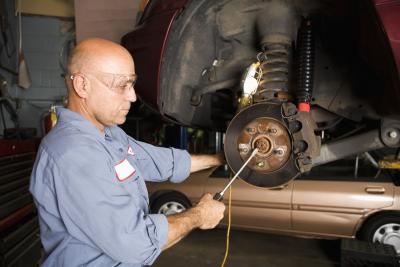
Troubleshooting brake problems in your 1997 Pontiac Grand Am just takes a few minutes using a logical and repeatable method of diagnosis. Each step in the process will allow you to rapidly evaluate the various components and functions of the brake system so you can develop an understanding of the overall condition of the brake system. When the system is evaluated in this manner, malfunctions become easy to identify and repair.
Sit in the driver's seat. Turn the ignition key to the "Off" position. Push the brake pedal several times to eliminate any residual power assist function in the power brake booster.
Push the brake pedal down hard with your foot and hold it for 30 seconds. During this test, the pistons in the brake master cylinder will be forced past the vent and replenish ports in the master cylinder, and the system is closed. If, during this test, the brake pedal begins to drop to the floor, there is a leak present in a brake line, wheel cylinder or caliper. Inspect each wheel visually for fluid residue to find the leak.
Ease up pressure slowly on the brake pedal, without removing your foot, until you are applying about the same pressure to the pedal as you would at a stop light. This test allows the master cylinder pistons to slide back into the bore and center between the vent and replenish ports in the master cylinder. If the pedal begins to drop during this test, the master cylinder is faulty and should be replaced.
Start the engine while continuing to hold the pedal down. When the engine starts, the pedal should drop about 2 inches as the power assist is activated in the system. If it doesn't drop, check for a vacuum leak at the vacuum source on the power brake booster located behind the master cylinder. If no vacuum leak is found, replace the booster.
Release and press the brake pedal a few times with the engine running. If the engine stumbles or a steady hissing noise is heard, the vent valve in the booster is defective. Replace the booster.
Apply the parking brake and shift the Grand Am into gear. The parking brake should hold the vehicle under very light throttle. If the parking brake does not hold the vehicle, adjust the rear brake shoes and parking brake cable.
Test-drive the car at highway speed. Note how the brakes feel when decelerating. Grinding or vibration under braking indicates faulty brake rotors and brake pads. Replace the pads and rotors.